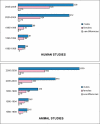How important are sex differences in cannabinoid action?
- PMID: 20590564
- PMCID: PMC2931555
- DOI: 10.1111/j.1476-5381.2010.00776.x
How important are sex differences in cannabinoid action?
Abstract
In humans as in animals, males and females are dissimilar in their genetic and hormonally driven behaviour; they process information differently, perceive experience and emotions in different ways, display diverse attitudes, language and social skills, and show sex-related differences in the brain anatomy and organization. Drug addiction is a widespread relapsing illness that affects both men and women. Sex-dependent differences have been frequently observed in the biological and behavioural effects of substances of abuse, including cannabis. Beside sex differences observed in the cannabinoid-induced effects related to cannabis abuse and dependence, cannabinoids have been shown to exert sex-dependent effects also in other physiological and behavioural aspects, such as food intake and energy balance (more evident in males), or anxiety and depression (more evident in females). Research has just begun to identify factors which could provide a neurobiological basis for gender-based differences in cannabinoid effects, among which, gonadal hormones seem to play a crucial role. Yet, cannabinoid pharmacodynamic and pharmacokinetic may also be important, as sex differences in cannabinoid effects might be due, at least in part, to differences in muscle mass and fat tissue distribution between males and females. Here, we will review both clinical and laboratory-based research evidence revealing important sex-related differences in cannabinoid effects, and put forward some suggestions for future studies to fill the gap in our knowledge of gender-specific bias in cannabinoid pharmacology.
Figures


References
-
- Adlaf EM, Paglia A. Drug Use among Ontario Students, 1977–2003: Findings from OSDUS. Toronto: Center for Addiction and Mental Health; 2003.
-
- Biscaia M, Marín S, Fernández B, Marco EM, Rubio M, Guaza C, et al. Chronic treatment with CP 55,940 during the peri-adolescent period differentially affects the behavioural responses of male and female rats in adulthood. Psychopharmacology. 2003;170:301–308. - PubMed
-
- Bradshaw HB, Rimmerman N, Krey JF, Walker JM. Sex and hormonal cycle differences in rat brain levels of pain-related cannabimimetic lipid mediators. Am J Physiol Regul Integr Comp Physiol. 2006;291:R349–R358. - PubMed
-
- Busch L, Sterin-Borda L, Borda E. Effects of castration on cannabinoid CB1 receptor expression and on the biological actions of cannabinoid in the parotid gland. Clin Exp Pharmacol Physiol. 2006;33:258–263. - PubMed
-
- Butters JE. Promoting healthy choices: the importance of differentiating between ordinary and high risk cannabis use among high-school students. Subst Use Misuse. 2005;40:845–855. - PubMed
Publication types
MeSH terms
Substances
LinkOut - more resources
Full Text Sources
Medical
Miscellaneous

